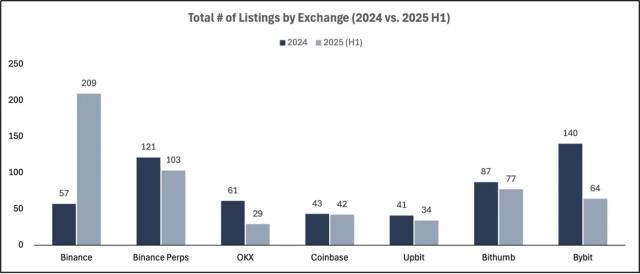Will a cycle led by institutions be exactly the same as the previous two cycles led by retail investors?
Written by: Aylo
Compiled by: Saoirse, Foresight News
Let's first consider a question: Do you think you can precisely sell at the market's highest point? The answer is actually quite clear - almost no one can do so, including myself, and there's no need to force it. The formation of a cycle top has a characteristic: it can quickly appear within a short-term time frame, but it's difficult to accurately identify before manifesting in higher time frames (HTFs).
Those focused on short-term trading, such as day traders, may capture some signals, but they have repeatedly called "top is here" so many times that these judgments have lost meaning - after all, they don't focus on the macro market context.
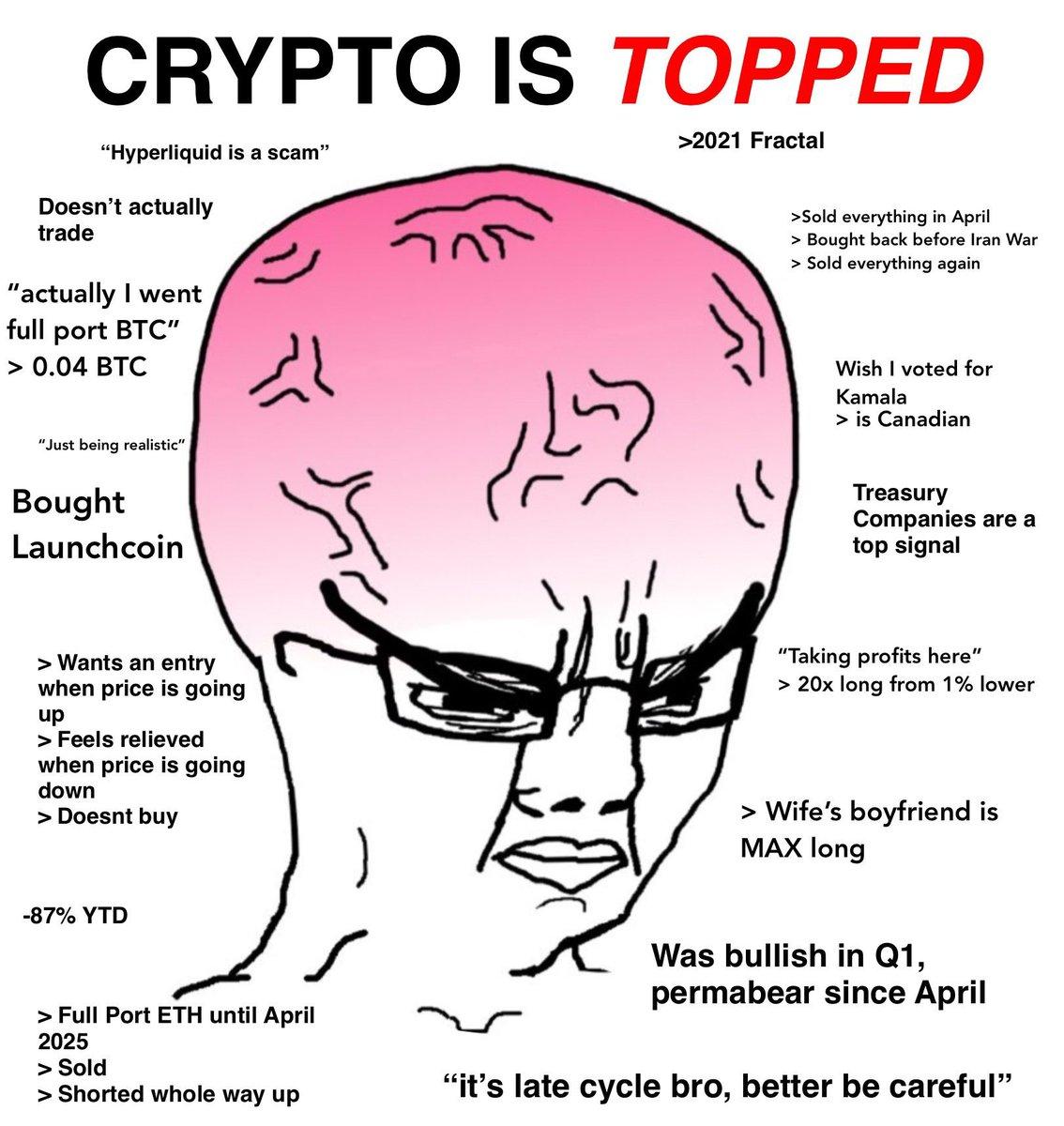
Therefore, regarding market cycles, you still need to observe and judge for yourself, making appropriate financial decisions. After all, markets change rapidly, and my views will also adjust with new data, serving only as a reference.
Arguments Supporting the "Four-Year Cycle Top"
Pattern Recognition Arguments:
Looking back at historical charts, an undeniable pattern emerges: cycle tops in December 2013, December 2017, and November 2021. The consistency of the four-year cycle is significant, and market patterns tend to persist until disrupted by fundamental changes.
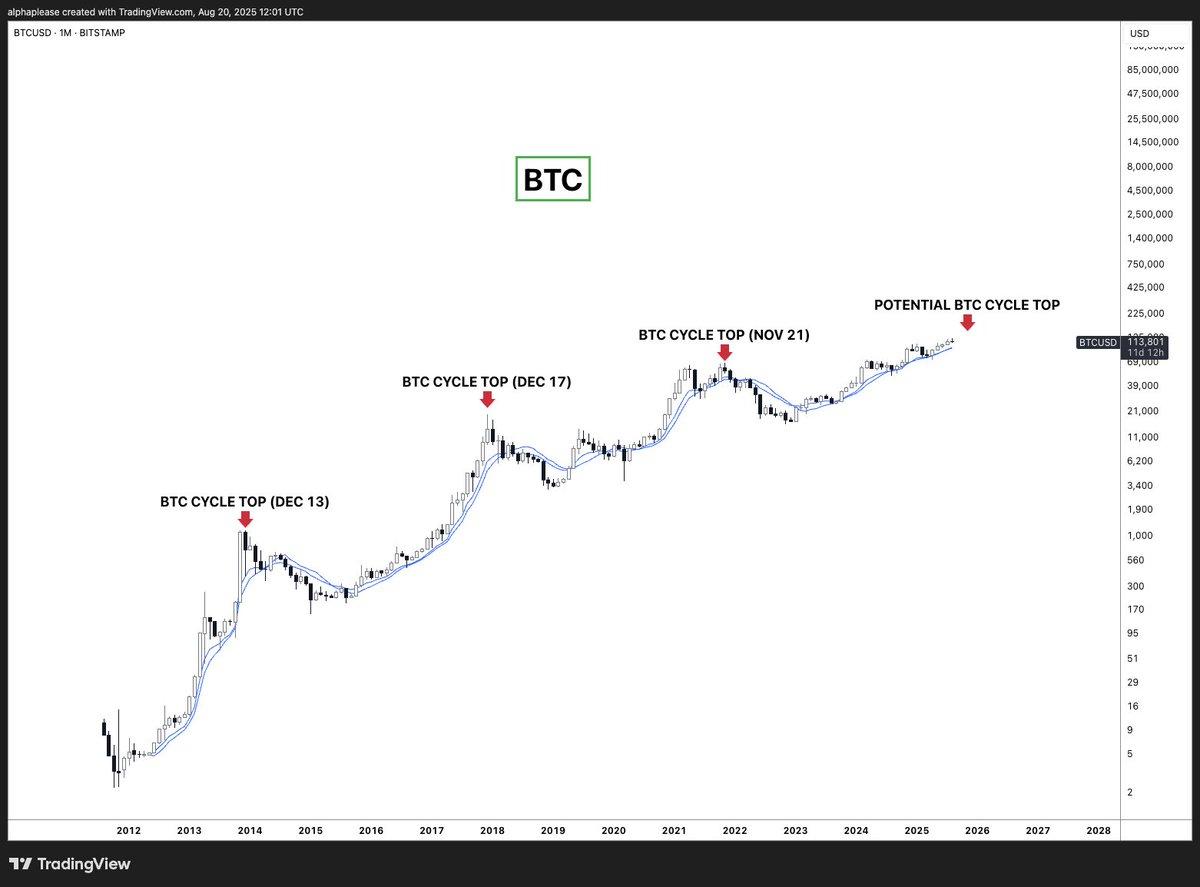
Reasons Why This Pattern Might Continue:
- Deeply Rooted Psychology: The four-year cycle is deeply ingrained in cryptocurrency market participants' cognition;
- Self-Fulfilling Prophecy: Widespread awareness of the cycle might trigger synchronized selling pressure, compounded by hidden leverage in the system (such as DATs);
- Halving Correlation: Bitcoin halving causes supply shocks, with historical peaks typically occurring 12-18 months after halving (though in this cycle, this is more like a market narrative);
- Occam's Razor: The simplest explanation is often closest to the truth - why complicate a pattern verified three times?
We are clearly no longer in the early stages of this cycle - Bitcoin has significantly risen from its bottom. Following this pattern, we should be approaching the peak range.
Arguments Against "Four-Year Cycle Top" (2026 Cycle Continuation Theory)
Fundamental Change Arguments:
I pose a simple question: Will a cycle led by institutions be exactly the same as the previous two cycles led by retail investors?
I generally agree that markets have cyclical nature, so I won't discuss "super cycles," but I believe cycles can be extended or shortened by other factors.
Reasons This Cycle Might Be Different:
1. Behavioral Differences Between Institutions and Retail Investors
- Spot ETF capital flows create an entirely new liquidity pattern compared to traditional exchanges;
- Institutional systematic profit-taking is smoother, unlike retail investors prone to panic selling;
2. Traditional Indicators May Become Ineffective
- We have many cycle analysis tools (like NVT, MVRV), but their historical data is based on retail-dominated markets;
- Institutional participation fundamentally changes the definition of "over-extension";
- Priced in gold, Bitcoin's current price hasn't even exceeded the previous cycle's high - far from a bubble zone;
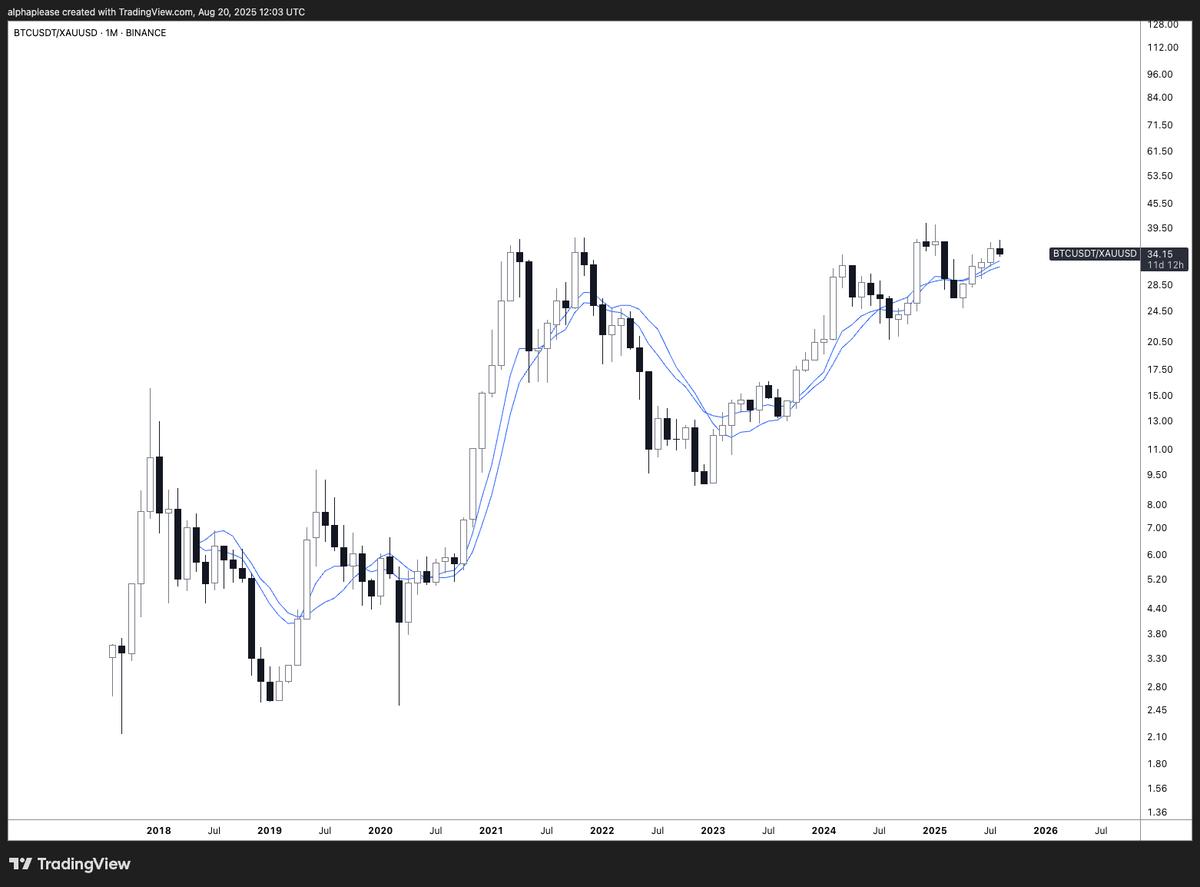
3. Radical Regulatory Environment Changes
- This cycle's regulatory environment is entirely different, with the US and SEC being more accepting of cryptocurrencies, forming a clear institutional participation framework;
- Previous cycle terminations were partly due to regulatory impacts (like 2018's ICO crackdown);
- The risk of systematic, sudden cycle termination has significantly decreased;
4. Macro and Federal Reserve Dynamics
- Fed Chair Powell's term ends in May 2026, with Trump potentially announcing a successor in late 2025;
- The "shadow Fed chair" dynamics weaken current policy effectiveness, and if markets expect Trump to nominate a dovish chair, it might trigger early buying pressure;
- The new Fed chair's first FOMC meeting is scheduled for June 17-18, 2026 - potentially a market catalyst;
- The transition period might maintain a "Goldilocks environment"
(Note: "Goldilocks environment" is a common financial market term originating from the fairy tale "Goldilocks and the Three Bears", meaning "not too hot, not too cold, just right". It suggests that during the transition period, economic and policy conditions might remain stable, supporting continued market growth.)
Federal Reserve Chair Transition Historical Patterns: Reviewing past transitions reveals a clear pattern:
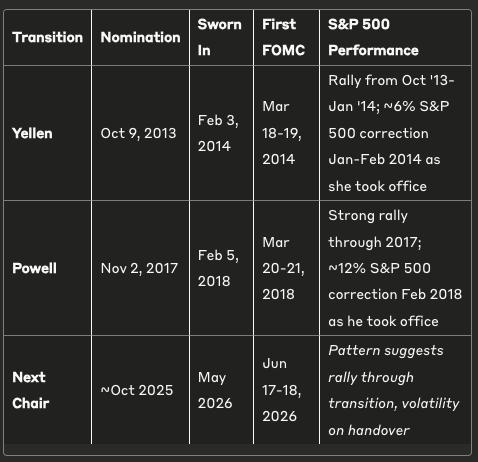
Both transitions show the same sequence - nomination news triggers market rises, with momentum continuing until transition completion, but the S&P 500 precisely corrects when the new chair takes office.
When Yellen took office, the S&P 500 fell about 6% in January-February 2014; when Powell took office, the index corrected about 12% in February 2018. This suggests that after Trump announces a nomination in late 2025, the bull market might continue until transition completion, with high probability of fluctuations around May-June 2026 - potentially coinciding with the cycle top.
5. Market Structure Changes
- Fears of currency devaluation have spawned new demand drivers, no longer limited to risk preference shifts;
- Stablecoin market cap can be a leading indicator - still growing (our "dry powder" indicator);
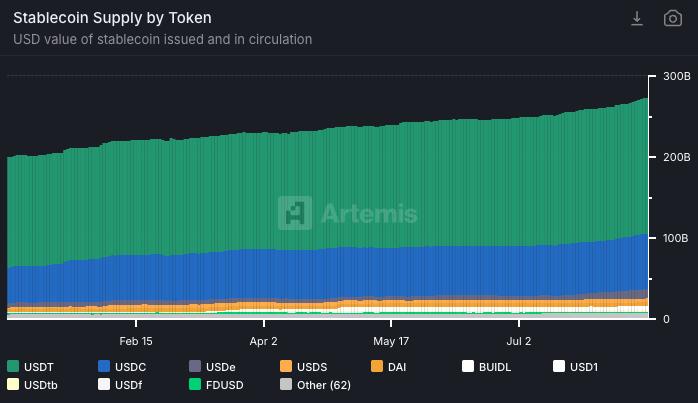
- Bitcoin's demand sources are more diverse than in previous cycles: ETFs, DATs, pension funds, etc.
What Factors Might Cause Early Cycle Termination or Four-Year Cycle Recurrence?
DAT Leverage Risk: I believe the primary bearish factor is DAT companies potentially liquidating faster than expected. Large-scale forced selling could overwhelm buyers and change market structure. However, losing buying demand (mNAVs dropping to 1) differs from becoming forced sellers causing a "crash".
Nevertheless, losing the primary DAT purchasing power is obviously significant. Many speculate this has already happened - Strategy and major ETH DAT companies' mNAVs have dramatically dropped. I'm not ignoring this, and you should also monitor it closely.
Macro Risks: Inflation rising again is the true macro risk, but no signs exist currently. Cryptocurrencies are now highly correlated with macroeconomic conditions, and we're still in a "Goldilocks environment".
Missing Elements of Cycle Top
Market euphoria has not yet appeared:
- The market hasn't overcome the "wall of worry" - every 5% pullback sparks cycle top speculation (ongoing for 18 months);

- Sustained euphoric sentiment and market consensus on further rises are absent;
- No "surge and crash" top characteristics (though not a necessary feature).
If cryptocurrencies experience significant rises later this year, significantly outperforming stocks, such a "surge and crash" signal might indicate the crypto top is far earlier than the potentially continuing 2026 business cycle.
Stablecoin Leading Indicator
An extremely valuable indicator: Stablecoin market cap growth.
In traditional finance, M2 money supply growth often precedes asset bubbles. In the cryptocurrency market, the market cap of stablecoins plays a similar role - representing the total "dollar" available within the crypto ecosystem.
Major cycle tops often coincide with stablecoin supply stagnation 3-6 months prior. As long as stablecoin supply continues to grow significantly, the market may still have upward momentum.
My Current Perspective
To be frank, based on current observations, I believe there won't be a major cycle top before 2026 (this view may change at any time due to new circumstances).
The historical data points for the four-year cycle are limited (only three instances), and institutional participation is a fundamental change in market structure. The dynamics of the Federal Reserve Chair transition alone could extend the "Goldilocks environment" until 2025 - which is particularly important, especially given the unprecedented correlation between cryptocurrencies and macroeconomic factors.
In this cycle, cryptocurrency market participants have a deeper understanding of the four-year cycle, which makes me think the results might be slightly different. When have the masses ever been completely correct?
Would everyone sell according to the four-year cycle pattern and exit unscathed?

However, I also acknowledge the significant consistency of the four-year cycle pattern, and market patterns tend to continue until they are broken. The market's awareness of the cycle might also become a self-fulfilling prophecy that ends it.
As Bitcoin's market cap proportion decreases, I will continue to gradually take profits on Altcoins with excessive gains; but I will hold Bitcoin, believing it will set a new high in 2026. It's important to note that regardless of the overall market cycle, the Altcoins you hold may top out at any time.
Final Thoughts
The four-year cycle pattern is the most compelling argument for a top in 2025 - it has been validated three times, and simplicity often prevails. However, the market structure changes driven by institutions, Federal Reserve Chair transition dynamics, and the absence of euphoric signals all suggest that this cycle might extend to 2026.
The situation may change dramatically in the coming months, so there's no need to be too stubborn about one's views.
In any case, accept that you cannot sell exactly at the highest point and develop a systematic exit strategy.
The appropriate position is one that allows you to sleep soundly. If you've already made substantial profits, selling "too early" is completely fine.







